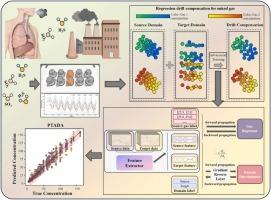PTADA: An unsupervised domain-adversarial regression algorithm for sensor drift in mixed gas scenarios
IF 3.7
1区 化学
Q1 CHEMISTRY, ANALYTICAL
引用次数: 0
Abstract
Compared to single-gas detection, regression prediction for mixed gas is more challenging, due to the feature diversity among different gas components and distribution discrepancy between source and target domains that caused by sensor drift effect. To address these challenges, we propose an unsupervised adversarial domain adaptation neural network called Progressive dual-stream Temporal network with Attention for Domain Adaptation (PTADA), offering an effective drift compensation solution for mixed gas regression tasks through adversarial learning. PTADA employs a multi-scale modeling approach to progressively extract local and global dependencies from temporal gas data, constructing a hierarchical temporal dependency structure and enhancing feature representation. Additionally, PTADA employs Multi-Kernel Maximum Mean Discrepancy (MK-MMD) for regularization to boost domain adaptation. Furthermore, to address the issue of sample imbalance in the concentration data, we designed a hybrid compressed focal loss function (H-Focal Loss) that combines linear error and logarithmic error. We evaluated PTADA on a self-collected H₂S–SO₂ mixed gas drift dataset, focusing on the novel and challenging task of regression-based drift compensation for mixed gases. The experimental results show that PTADA achieved R² values of 0.924 and 0.937 for H₂S and SO₂, respectively, outperforming traditional models and other drift compensation methods (such as Informer, SWD, and ADDA), which highlights its significant advantages in regression tasks under mixed gas drift conditions. Furthermore, noise resistance and sensor failure experiments verified the robustness of PTADA, and additional tests on public dataset and other mixed gas dataset demonstrated its strong generalization capability.

PTADA:一种用于混合气体情况下传感器漂移的无监督域对抗回归算法
与单一气体检测相比,混合气体的回归预测更具挑战性,因为不同气体成分之间的特征差异以及传感器漂移效应导致的源域和目标域分布差异。为了解决这些挑战,我们提出了一种无监督的对抗性领域自适应神经网络,称为渐进式双流时域网络(Progressive dual-stream Temporal network with Attention for domain adaptation, PTADA),通过对抗性学习为混合气体回归任务提供了有效的漂移补偿解决方案。PTADA采用多尺度建模方法,从时序气体数据中逐步提取局部和全局依赖关系,构建层次化时序依赖结构,增强特征表示。此外,PTADA采用多核最大平均差异(MK-MMD)进行正则化,提高域自适应能力。此外,为了解决浓度数据中样本不平衡的问题,我们设计了一个混合压缩焦损失函数(H-Focal loss),该函数结合了线性误差和对数误差。我们在自收集的H₂S-SO₂混合气体漂移数据集上评估了PTADA,重点研究了基于回归的混合气体漂移补偿这一新颖而具有挑战性的任务。实验结果表明,PTADA对H₂S和SO₂的R²值分别为0.924和0.937,优于传统模型和其他漂移补偿方法(如Informer、SWD和ADDA),在混合气体漂移条件下的回归任务中具有显著优势。此外,通过抗噪声和传感器故障实验验证了PTADA的鲁棒性,并在公共数据集和其他混合气体数据集上进行了测试,证明了其强大的泛化能力。
本文章由计算机程序翻译,如有差异,请以英文原文为准。
求助全文
约1分钟内获得全文
求助全文
来源期刊

Sensors and Actuators B: Chemical
工程技术-电化学
CiteScore
14.60
自引率
11.90%
发文量
1776
审稿时长
3.2 months
期刊介绍:
Sensors & Actuators, B: Chemical is an international journal focused on the research and development of chemical transducers. It covers chemical sensors and biosensors, chemical actuators, and analytical microsystems. The journal is interdisciplinary, aiming to publish original works showcasing substantial advancements beyond the current state of the art in these fields, with practical applicability to solving meaningful analytical problems. Review articles are accepted by invitation from an Editor of the journal.
 求助内容:
求助内容: 应助结果提醒方式:
应助结果提醒方式:


